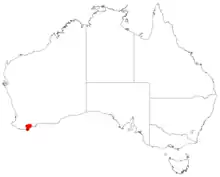| Leucopogon bracteolaris | |
|---|---|
| Scientific classification | |
| Kingdom: | Plantae |
| Clade: | Tracheophytes |
| Clade: | Angiosperms |
| Clade: | Eudicots |
| Clade: | Asterids |
| Order: | Ericales |
| Family: | Ericaceae |
| Genus: | Leucopogon |
| Species: | L. bracteolaris |
| Binomial name | |
| Leucopogon bracteolaris | |
 | |
| Occurrence data from AVH | |
| Synonyms[1] | |
|
Styphelia bracteolaris (Benth.) F.Muell. | |
Leucopogon bracteolaris is a species of flowering plant in the heath family Ericaceae and is endemic to the south-west of Western Australia. It is an erect shrub with egg-shaped to broadly lance-shaped leaves with the narrower end towards the base, about 4 mm (0.16 in) long. The leaves sometimes have a stem-clasping base, and are covered with fine hairs. The flowers are arranged in large, cylindrical spikes on the ends of branches with leaf-like, lance-shaped bracts and bracteoles almost as long as the sepals. The sepals are about 2 mm (0.079 in) long and lance-shaped, the petal tube is slightly longer than the sepals, and the petal lobes are longer than the petal tube.[2]
It was first formally described in 1868 by George Bentham in Flora Australiensis.[2][3] The specific epithet (bracteolaris) means "having bracteoles".[4]
This leucopogon occurs in the Esperance plains and Jarrah Forest bioregions of the south-west of Western Australia and is listed as "Priority Two" by the Western Australian Government Department of Biodiversity, Conservation and Attractions,[5] meaning that it is poorly known and from only one or a few locations.[6]
References
- 1 2 "Leucopogon bracteolaris". Australian Plant Census. Retrieved 1 July 2022.
- 1 2 Bentham, George; von Mueller, Ferdinand (1868). Flora Australiensis. Vol. 4. London: Lovell Reeve & Co. p. 197. Retrieved 1 July 2022.
- ↑ "Leucopogon bracteolaris". APNI. Retrieved 1 July 2022.
- ↑ Sharr, Francis Aubi; George, Alex (2019). Western Australian Plant Names and Their Meanings (3rd ed.). Kardinya, WA: Four Gables Press. p. 149. ISBN 9780958034180.
- ↑ "Leucopogon bracteolaris". FloraBase. Western Australian Government Department of Biodiversity, Conservation and Attractions.
- ↑ "Conservation codes for Western Australian Flora and Fauna" (PDF). Government of Western Australia Department of Parks and Wildlife. Retrieved 1 July 2022.
